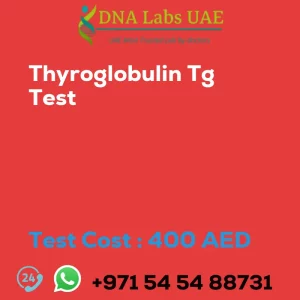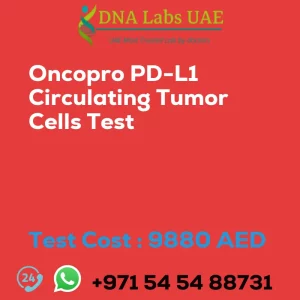IMMUNOHISTOCHEMISTRY VIMENTIN Test
Test Cost: AED 410.0
Symptoms, Diagnosis, and Test Details
Are you experiencing symptoms that may indicate a potential cancer diagnosis? DNA Labs UAE offers the IMMUNOHISTOCHEMISTRY VIMENTIN test, a laboratory technique used to detect the presence and distribution of vimentin protein in tissue samples. Vimentin is an intermediate filament protein found in cells of mesenchymal origin, including fibroblasts, endothelial cells, and immune cells.
Before undergoing the IMMUNOHISTOCHEMISTRY VIMENTIN test, it is important to provide a copy of the Histopathology report, site of biopsy, and clinical history to our test department. This information will help our oncologist and pathologist better understand your case and provide accurate results.
Test Components and Sample Condition
The IMMUNOHISTOCHEMISTRY VIMENTIN test costs AED 410.0. To ensure accurate results, please submit a tumor tissue in 10% Formal-saline or a Formalin fixed paraffin embedded block. Please ship the sample at room temperature and include a copy of the Histopathology report, site of biopsy, and clinical history.
Report Delivery and Test Department
Our goal is to provide timely and efficient services. Sample delivery for the IMMUNOHISTOCHEMISTRY VIMENTIN test is daily by 6 pm, and the report will be delivered within 5 days for the report block, tissue biopsy, and tissue large complex.
If you have any questions or concerns, our oncologist and pathologist are available to assist you throughout the process.
Method and Test Type
The IMMUNOHISTOCHEMISTRY VIMENTIN test is conducted using immunohistochemistry, a laboratory technique that involves several steps:
- Tissue Preparation: Tissue samples are collected and fixed using formalin or other fixatives to preserve the cellular structure.
- Sectioning: The fixed tissue is embedded in paraffin wax and cut into thin sections (usually 4-6 micrometers thick) using a microtome.
- Deparaffinization and Rehydration: The paraffin is removed from the tissue sections using xylene or other solvents, followed by rehydration through a series of graded alcohols.
- Antigen Retrieval: The tissue sections are subjected to antigen retrieval, which involves heating the samples in a buffer solution to expose the vimentin protein epitopes.
- Blocking: To prevent non-specific binding, the tissue sections are treated with a blocking agent, such as bovine serum albumin or normal serum.
- Primary Antibody Incubation: The tissue sections are incubated with a primary antibody specific to vimentin. The primary antibody binds to the vimentin protein present in the tissue.
- Secondary Antibody Incubation: After washing off unbound primary antibody, a secondary antibody conjugated to a detection molecule (e.g., enzyme, fluorophore) is applied. This secondary antibody binds to the primary antibody, amplifying the signal.
- Visualization: If an enzyme-linked secondary antibody is used, a chromogenic substrate is added, resulting in the development of a visible color reaction. If a fluorophore-conjugated secondary antibody is used, fluorescence microscopy is used to visualize the vimentin distribution.
- Counterstaining and Mounting: To enhance the contrast and visualize the tissue architecture, the tissue sections may be counterstained with dyes like hematoxylin. Finally, the sections are mounted on glass slides using a mounting medium.
The IMMUNOHISTOCHEMISTRY VIMENTIN test allows researchers and pathologists to examine the expression and localization of vimentin in various tissues. Abnormal expression or distribution of vimentin can indicate pathological conditions, such as cancer metastasis or tissue damage.
Trust DNA Labs UAE for accurate and reliable genetic testing services. Contact us today to schedule your IMMUNOHISTOCHEMISTRY VIMENTIN test.
| Test Name | IMMUNOHISTOCHEMISTRY VIMENTIN Test |
|---|---|
| Components | |
| Price | 410.0 AED |
| Sample Condition | Submit tumor tissue in 10% Formal-saline OR Formalin fixed paraffin embedded block. Ship at room temperature. Provide a copy of the Histopathology report, Site of biopsy and Clinical history. |
| Report Delivery | Sample Daily by 6 pm; Report Block: 5 days Tissue Biopsy: 5 days Tissue large complex : 7 days |
| Method | Immunohistochemistry |
| Test type | Cancer |
| Doctor | Oncologist, Pathologist |
| Test Department: | |
| Pre Test Information | Provide a copy of the Histopathology report, Site of biopsy and Clinical history. |
| Test Details |
Immunohistochemistry (IHC) Vimentin test is a laboratory technique used to detect the presence and distribution of vimentin protein in tissue samples. Vimentin is an intermediate filament protein found in cells of mesenchymal origin, including fibroblasts, endothelial cells, and immune cells. The IHC Vimentin test involves the following steps: 1. Tissue Preparation: Tissue samples are collected and fixed using formalin or other fixatives to preserve the cellular structure. 2. Sectioning: The fixed tissue is embedded in paraffin wax and cut into thin sections (usually 4-6 micrometers thick) using a microtome. 3. Deparaffinization and Rehydration: The paraffin is removed from the tissue sections using xylene or other solvents, followed by rehydration through a series of graded alcohols. 4. Antigen Retrieval: The tissue sections are subjected to antigen retrieval, which involves heating the samples in a buffer solution to expose the vimentin protein epitopes. 5. Blocking: To prevent non-specific binding, the tissue sections are treated with a blocking agent, such as bovine serum albumin or normal serum. 6. Primary Antibody Incubation: The tissue sections are incubated with a primary antibody specific to vimentin. The primary antibody binds to the vimentin protein present in the tissue. 7. Secondary Antibody Incubation: After washing off unbound primary antibody, a secondary antibody conjugated to a detection molecule (e.g., enzyme, fluorophore) is applied. This secondary antibody binds to the primary antibody, amplifying the signal. 8. Visualization: If an enzyme-linked secondary antibody is used, a chromogenic substrate is added, resulting in the development of a visible color reaction. If a fluorophore-conjugated secondary antibody is used, fluorescence microscopy is used to visualize the vimentin distribution. 9. Counterstaining and Mounting: To enhance the contrast and visualize the tissue architecture, the tissue sections may be counterstained with dyes like hematoxylin. Finally, the sections are mounted on glass slides using a mounting medium. The IHC Vimentin test allows researchers and pathologists to examine the expression and localization of vimentin in various tissues. Abnormal expression or distribution of vimentin can indicate pathological conditions, such as cancer metastasis or tissue damage. |








